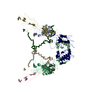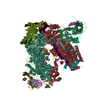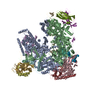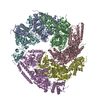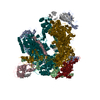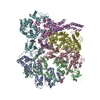+ Open data
Open data
- Basic information
Basic information
| Entry | Database: SASBDB / ID: SASDHE2 |
|---|---|
 Sample Sample | Type 1 insulin-like growth factor receptor ectodomains (IGF-1RΔβ)
|
| Function / homology |  Function and homology information Function and homology informationprotein kinase complex / insulin-like growth factor receptor activity / insulin-like growth factor binding / Signaling by Type 1 Insulin-like Growth Factor 1 Receptor (IGF1R) / protein transporter activity / IRS-related events triggered by IGF1R / transcytosis / insulin receptor complex / insulin-like growth factor I binding / positive regulation of protein-containing complex disassembly ...protein kinase complex / insulin-like growth factor receptor activity / insulin-like growth factor binding / Signaling by Type 1 Insulin-like Growth Factor 1 Receptor (IGF1R) / protein transporter activity / IRS-related events triggered by IGF1R / transcytosis / insulin receptor complex / insulin-like growth factor I binding / positive regulation of protein-containing complex disassembly / insulin receptor activity / alphav-beta3 integrin-IGF-1-IGF1R complex / regulation of JNK cascade / dendritic spine maintenance / peptidyl-tyrosine autophosphorylation / insulin binding / amyloid-beta clearance / Respiratory syncytial virus (RSV) attachment and entry / insulin receptor substrate binding / SHC-related events triggered by IGF1R / phosphatidylinositol 3-kinase binding / negative regulation of MAPK cascade / insulin-like growth factor receptor signaling pathway / insulin receptor binding / cellular response to glucose stimulus / phosphatidylinositol 3-kinase/protein kinase B signal transduction / receptor protein-tyrosine kinase / cellular response to amyloid-beta / insulin receptor signaling pathway / positive regulation of cold-induced thermogenesis / protein autophosphorylation / protein tyrosine kinase activity / Extra-nuclear estrogen signaling / positive regulation of phosphatidylinositol 3-kinase/protein kinase B signal transduction / receptor complex / positive regulation of MAPK cascade / immune response / cilium / positive regulation of cell migration / axon / intracellular membrane-bounded organelle / positive regulation of cell population proliferation / negative regulation of apoptotic process / nucleolus / signal transduction / ATP binding / identical protein binding / membrane / plasma membrane Similarity search - Function |
| Biological species |  Homo sapiens (human) Homo sapiens (human) |
 Citation Citation |  Journal: J Mol Biol / Year: 2009 Journal: J Mol Biol / Year: 2009Title: Solution structure of ectodomains of the insulin receptor family: the ectodomain of the type 1 insulin-like growth factor receptor displays asymmetry of ligand binding accompanied by limited conformational change. Authors: Andrew E Whitten / Brian J Smith / John G Menting / Mai B Margetts / Neil M McKern / George O Lovrecz / Timothy E Adams / Kim Richards / John D Bentley / Jill Trewhella / Colin W Ward / Michael C Lawrence /  Abstract: The insulin receptor (IR) and the homologous Type 1 insulin-like growth factor receptor (IGF-1R) are cell-surface tyrosine kinase receptors that effect signaling within the respective pathways of ...The insulin receptor (IR) and the homologous Type 1 insulin-like growth factor receptor (IGF-1R) are cell-surface tyrosine kinase receptors that effect signaling within the respective pathways of glucose metabolism and normal human growth. While ligand binding to these receptors is assumed to result in a structural transition within the receptor ectodomain that then effects signal transduction across the cell membrane, little is known about the molecular detail of these events. Presented here are small-angle X-ray scattering data obtained from the IR and IGF-1R ectodomains in solution. We show that, in solution, the ectodomains of IR and IGF-1R have a domain disposition that is very similar to that seen in the crystal structure of the ectodomain of IR, despite the constituent domains being in relatively sparse contact and potentially mobile. We also show that the IGF-1R ectodomain is capable of binding up to three molecules of IGF-1 in solution, with surprisingly little apparent change in relative domain disposition compared to the apo form. While the observed 3:1 ligand-binding stoichiometry appears to contradict earlier explanations of the absence of a bell-shaped dose-response curve for IGF-1R in ligand displacement assays, it is readily understood in the context of the harmonic oscillator model of the negative cooperativity of ligand binding to IGF-1R. Taken together, our findings suggest that the structural movements within these receptors upon ligand binding are small and are possibly limited to local rotation of domains. |
 Contact author Contact author |
|
- Structure visualization
Structure visualization
| Structure viewer | Molecule:  Molmil Molmil Jmol/JSmol Jmol/JSmol |
|---|
- Downloads & links
Downloads & links
-Data source
| SASBDB page |  SASDHE2 SASDHE2 |
|---|
-Related structure data
| Related structure data | C: citing same article ( |
|---|---|
| Similar structure data |
- External links
External links
| Related items in Molecule of the Month |
|---|
-Models
| Model #3922 |  Type: atomic / Software: (8) / Radius of dummy atoms: 1.90 A / Symmetry: C2 / Chi-square value: 0.7396 / P-value: 0.095263  Search similar-shape structures of this assembly by Omokage search (details) Search similar-shape structures of this assembly by Omokage search (details) |
|---|
- Sample
Sample
 Sample Sample | Name: Type 1 insulin-like growth factor receptor ectodomains (IGF-1RΔβ) Specimen concentration: 2 mg/ml |
|---|---|
| Buffer | Name: 30 mM Tris, 140 mM NaCl, 0.02% w/v sodium azide, / pH: 7.5 |
| Entity #1965 | Name: IGF1R / Type: protein / Description: Insulin-like growth factor 1 receptor / Formula weight: 101.032 / Num. of mol.: 2 / Source: Homo sapiens / References: UniProt: P08069 Sequence: EICGPGIDIR NDYQQLKRLE NCTVIEGYLH ILLISKAEDY RSYRFPKLTV ITEYLLLFRV AGLESLGDLF PNLTVIRGWK LFYNYALVIF EMTNLKDIGL YNLRNITRGA IRIEKNADLC YLSTVDWSLI LDAVSNNYIV GNKPPKECGD LCPGTMEEKP MCEKTTINNE ...Sequence: EICGPGIDIR NDYQQLKRLE NCTVIEGYLH ILLISKAEDY RSYRFPKLTV ITEYLLLFRV AGLESLGDLF PNLTVIRGWK LFYNYALVIF EMTNLKDIGL YNLRNITRGA IRIEKNADLC YLSTVDWSLI LDAVSNNYIV GNKPPKECGD LCPGTMEEKP MCEKTTINNE YNYRCWTTNR CQKMCPSTCG KRACTENNEC CHPECLGSCS APDNDTACVA CRHYYYAGVC VPACPPNTYR FEGWRCVDRD FCANILSAES SDSEGFVIHD GECMQECPSG FIRNGSQSMY CIPCEGPCPK VCEEEKKTKT IDSVTSAQML QGCTIFKGNL LINIRRGNNI ASELENFMGL IEVVTGYVKI RHSHALVSLS FLKNLRLILG EEQLEGNYSF YVLDNQNLQQ LWDWDHRNLT IKAGKMYFAF NPKLCVSEIY RMEEVTGTKG RQSKGDINTR NNGERASCES DVLHFTSTTT SKNRIIITWH RYRPPDYRDL ISFTVYYKEA PFKNVTEYDG QDACGSNSWN MVDVDLPPNK DVEPGILLHG LKPWTQYAVY VKAVTLTMVE NDHIRGAKSE ILYIRTNASV PSIPLDVLSA SNSSSQLIVK WNPPSLPNGN LSYYIVRWQR QPQDGYLYRH NYCSKDKIPI RKYADGTIDI EEVTENPKTE VCGGEKGPCC ACPKTEAEKQ AEKEEAEYRK VFENFLHNSI FVPRPERKRR DVMQVANTTM SETEYPFFES RVDNKERTVI SNLRPFTLYR IDIHSCNHEA EKLGCSASNF VFARTMPAEG ADDIPGPVTW EPRPENSIFL KWPEPENPNG LILMYEIKYG SQVEDQRECV SRQEYRKYGG AKLNRLNPGN YTARIQATSL SGNGSWTDPV FFYVQAKTGY ENFIH |
-Experimental information
| Beam | Instrument name: Australian Nuclear Science and Technology Organisation Bruker Nanostar City: Lucas Heights / 国: Australia  / Type of source: X-ray in house / Wavelength: 0.15406 Å / Dist. spec. to detc.: 1.124 mm / Type of source: X-ray in house / Wavelength: 0.15406 Å / Dist. spec. to detc.: 1.124 mm | ||||||||||||||||||||||||||||||||||||||||||
|---|---|---|---|---|---|---|---|---|---|---|---|---|---|---|---|---|---|---|---|---|---|---|---|---|---|---|---|---|---|---|---|---|---|---|---|---|---|---|---|---|---|---|---|
| Detector | Name: VÅNTEC 2000 / Type: Xe-based gaseous avalanche detector / Pixsize x: 68 mm | ||||||||||||||||||||||||||||||||||||||||||
| Scan | Measurement date: Apr 22, 2008 / Storage temperature: 4 °C / Cell temperature: 4 °C / Exposure time: 1800 sec. / Number of frames: 2 / Unit: 1/A /
| ||||||||||||||||||||||||||||||||||||||||||
| Distance distribution function P(R) |
| ||||||||||||||||||||||||||||||||||||||||||
| Result | Comments: Additional modelling information, including summaries for the related entry SASDHF2 (Insulin receptor ectodomains, IRΔβ), are provided in the full entry zip-archive.
|
 Movie
Movie Controller
Controller


